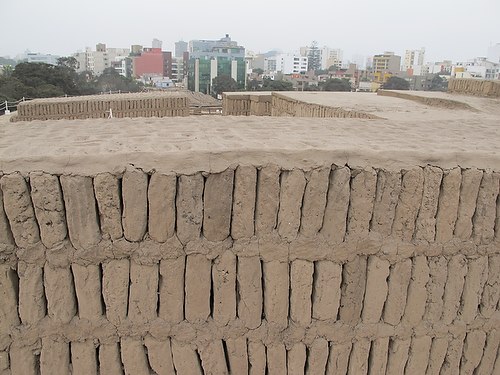Who knew that Lima’s fashionable Miraflores district was the site of an ancient ruin? Most Limeños, in fact, didn’t even know until relatively recently.
This was the version presented by Alejandro Olivo, our guide, whose grandfather farmed these lands and who used to play soccer here when he was a boy. As far as he knew, these were just hills, and what was once a city off 44 temples was leveled by the wealthy Marsano family in the 1980s to make way for what is now Miraflores. The government finally intervened to seize the land and opened a park and a small visitor’s center here in 1991, and subsequent archaeological investigations revealed a fascinating slice of Lima antiquity.

The brick pyramids stand out today against a backdrop of skyscrapers and city streets, a juxtaposition of ancient and modern that serves as an apt metaphor for Lima itself.
Today seven pyramids remain of the original 44, and most of the site has not been fully excavated. What has emerged is a picture of a ceremonial site of the Lima culture, dating from 200-700 AD, where ritual games were played – the name “Huaca Pucllana” means “sacred place to play.”
The remains of some 170 bodies have been discovered, with some important distinctions. About 60 were wrapped in burial cloths and placed on wooden beds, then buried with offerings. These were the royalty, Olivo explained. There were also the remains of 50 babies, who were apparently sacrificed as offerings, or to accompany the royalty to the land of the dead.
Most striking were the remains of 60 young women, who were apparently sacrificed as an offering to the gods. Their bodies were found mutilated and tossed in a corner.
Unlike Caral, Macchu Pichu and other stone-based cities, Huaca Pucllana was built of handmade bricks, and in the courtyard of the structure, two figures of men show the process. The figures also serve to show the stature of the people, who were tiny by modern standards; most were around four feet tall.

Similar to Caral, however, Huaca Pucllana employed sophisticated anti-seismic techniques. In the case of Caral, bags made of fibers were filled with rocks and the walls were built around these bags of rocks. Here in Huaca Pucllana, the builders employed an innovative structural device, leaving space between the bricks and slightly tilting them in alternating directions.
Perhaps the best way to enjoy Huaca Pucllana is to see it twice. The museum closes at 4:30 and the tour is around 45 minutes, so arrive in the daytime. But return at night for a meal at the lovely restaurant on-site, and to enjoy the pyramids lit up against the night sky. It’s an experience you won’t forget.
Created with Admarket’s flickrSLiDR.

Leave a Reply